Swales at Mekse
On a permacultural technic of landscaping and water management
Water issue in agriculture, forestry and garden management cannot be reduced to a question of water lack or proficiency. Indeed, a piece of land can lack water AND be submerged by water. Solutions cannot be reduced to increasing water supply, since all of it can be gulp down by a too draining soil or dried out by the sun rays in hot summer.
In our project of nature park at Mekse, the water issue is that of the extremes. The climate in Bekaa valley is a Mediterranean climate amplified by the altitude. Winters are very cold, and rain is abundant during five months, but seven months are totally dry and summers very hot. Hence, our site happened to be a wetland in winter, and a xeric land in summertime. Few are the plants that resist such extremes: their roots suffocate and rotten in winter, and their leaves are burned out in summer. So, how to reduce water in wintertime and store it for summertime? How to protect the land from winter deluge and from the harshness of sunrays in summer?
The solution we developed is based on swales. Swales are a permacultural technic for rainwater harvesting and soil conservation developed by Bill Mollison and David Holmgren. It consists in shallow channels dug on the gentle slopes of a site. They are dug horizontally across the landscape (along an elevation contour line), and the earth taken from the trench is put on its low side to form a hill along the channel. Such swales are dug parallelly every twenty meters. This way, water running down the slope falls in the channels and the little hills block it. In winter, the series of swales gather the water and keep the soil between them aerated. In the same time, it keeps water on the land, prevents it to run out of the site and facilitates the runoff infiltration into the soil.
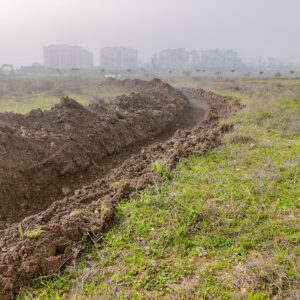
Swale in Mekse. © GdV
However, in Mekse nature park, the issue is not only to harvest rainwater, it also consists in distributing it, or even in getting rid of it. So, we connected the swales with a web of irrigation channels and a drainage system.
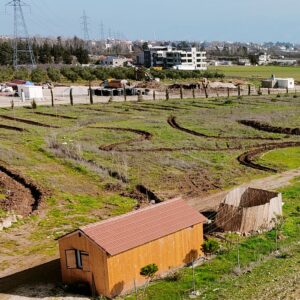
Swales and trenches in the Northern part of the site. © GdV
The work was carried out in the beginning of the winter, after the first rains that soften the soil and allowed to dig easily, but before main rains that would have prevented to work on a flooded land. Swales got dug. The trenche got planted with poplars which roots can live in the water and which constantly need humidity, and the upper part, which will be always stay dry welcomed acorns of endemic oak trees developing on the dry slopes of the mountains.
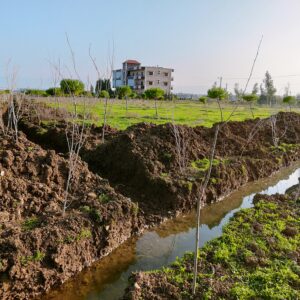
Swale connected with an irrigation channel and planted with poplars. © GdV
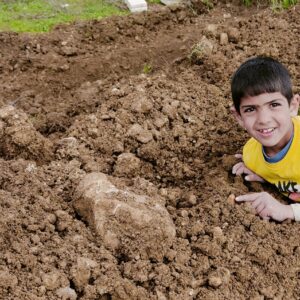
Nouh planting germinated acorns on the top of a swale in December
The first result in winter was the gathering of runoff water, and the sprouting of seedlings in Spring.

February. During the winter, acorns are protected from flood on the hill, and poplars develop roots in water. © Abbes
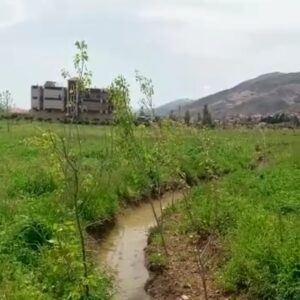
April.Poplar develop a splendid foliage. © Abbes
Then, it is time to check the acorns, and protect the young oak trees.

June. Oak tree sprout. © GdV
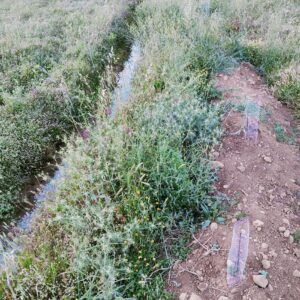
© GdV
In the beginning of the summer, swales are opened on irrigation canals to spread the remaining runoff water on the land among trees before the drought.
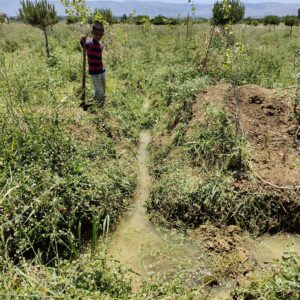
June. Opening of the channel. © GdV
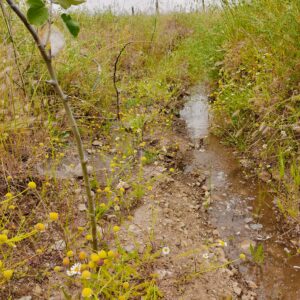
© GdV
It is expected that, in the heat of the summer, swales will provide a shadowed micro-climate protected from sun rays and gather organic matter brought by the wind. The hills will cut the wind near the surface of the land, and prevent the soil to dry out. Our hens already rest there from the heat of the day.
Whereas a drip system is an economic of watering in which one save water and distribute it scarcely to individual plants, a swale system is an ecology of watering that consider the soil as a whole, and try to work with the qualities of the soil, and not against it.